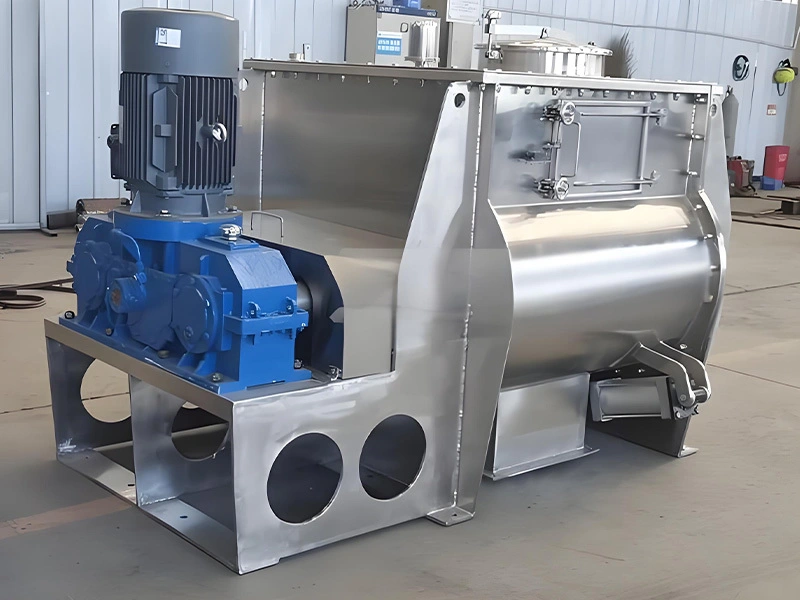19+ years of experience - Comprehensive solutions supplier for mixing and packaging of powder and granular materials.
Double-shaft gravity-free mixer
● The material is in a weightless state during the mixing process, reducing stratification and segregation, and ensuring mixing uniformity.
● It is designed with a special discharge system and a well-sealed door opening mechanism to ensure that there is no residue during discharge and no leakage occurs.
● The paddle blades are designed as two-pieces, and the worn small blades can be directly replaced without overall replacement, and the maintenance cost is low
Product Description
The dual-axis gravity-free mixer is widely used in industries such as chemical, food, pharmaceutical, and feed processing. It is designed for mixing powders, granules, fibers, and other materials. Its key feature lies in the centrifugal force, gravity, and convection generated by the dual-axis rotation, which causes the materials to enter a "gravity-free" state during the mixing process.
This enables rapid and homogeneous blending, even for materials with significant differences in physical properties such as specific gravity, fineness, and flowability. The mixer excels in handling mixtures of materials that vary greatly in these characteristics, ensuring high efficiency and uniform results.
Important note: Equipment selection is a relatively important link. Please provide detailed information about the materials and process arrangements as much as possible so that our professionals can provide you with high-quality technical services.
Working Principle
The gravity-free mixer is equipped with two parallel blade shafts that rotate synchronously in opposite outward directions. Each shaft is fitted with cross-shaped blades. Driven by a synchronized mechanism, the intersecting motion paths of the two cross-bladed shafts overlap and engage in an offset meshing pattern.
When the driving system activates the rapid rotation of the blade shafts, the centrifugal force generated by the spinning blades propels the material upward into the parabolic trajectory within the mixing chamber. At the peak of this parabola (referred to as the "momentary gravity-free state"), the material begins to descend. It is then guided back by the blades, undergoing repeated cycles of circulation and blending within the chamber. Simultaneously, the material is subjected to mixing, shearing, and separation in the overlapping zones between the dual shafts. This dual-action mechanism ensures quick and homogeneous mixing, even for materials with challenging physical disparities.
1.1 Feed valve 2.1 Mixer tank 2.2 Observation door 2.3 Plough share 2.4 Discharge port 2.5 Liquid sprinkler 2.6 Flying cutter group
Support customization
The mixer is customizable based on material, industry, and process requirements:
● Material Options: Carbon steel, manganese steel, stainless steel, or other specialized steel alloys.
● Functional Upgrades: Optional internal coatings or protective layers for anti-corrosion, anti-adhesion, isolation, or wear resistance, tailored to specific operational demands.
Drive System Configuration
The dual-axis gravity-free mixer is equipped with drive units of varying capacities, power ratings, and output speeds, tailored to material properties, startup methods, and mixing requirements. Due to the intermeshing relationship of the internal blades, the dual-axis drive system must possess synchronization capabilities. Four drive configurations are available for different operational needs:
|
Dual Gearbox Synchronized Combination |
Features two interconnected gearboxes for precise synchronization, ideal for high-torque applications. |
|
|
Single Gearbox Dual-Output Design |
Utilizes a single gearbox with dual output shafts to drive both axes, offering compactness and cost efficiency. |
|
|
Dual Planetary Gear Synchronized System |
Employs planetary gear mechanisms for high-precision synchronization and load distribution, suited for heavy-duty mixing. |
|
|
Bridge Sprocket-Chain Drive |
A chain-and-sprocket linkage system for economical synchronization in moderate-load scenarios. |
|
Internal structure diagram
Mixer Configuration Based on Material Properties
To accommodate diverse material characteristics, the dual-axis gravity-free mixer can be customized with specialized agitators, including:
- Wear-resistant blades for abrasive or high-friction materials.
- PTFE-coated blades for corrosive or chemically reactive substances.
- Serrated blades to enhance shearing and blending efficiency for fibrous or cohesive materials
The double-shaft zero-gravity mixer is usually equipped with a double-door flap, a large-opening discharge valve, and a curved flap valve that fits the curved surface of the cylinder completely, ensuring that there is no dead angle in the mixing and making the mixed materials more uniform.
Customizable Openings
Depending on operational requirements, the mixer's top openings can be configured with:
Functional Ports: Access hatches, cleanout doors, feed inlets, vents, or dust extraction ports.
Opening Styles:
● Flanged Standard Ports – For secure, leak-proof connections.
● Quick-Open Cover Doors – Hinged or removable covers for rapid access.
● Full-Opening Chamber Cover – Entire top section opens for unrestricted internal access and cleaning.
The mixer is designed with three sealing modes to address spindle sealing challenges for materials in granular, powdered, micron-level powdered, liquid, or slurry states:
● Packing Seal
● Combined Pneumatic Seal
● Mechanical Seal
Can be equipped with a variety of components
|
Specifications |
Effective volume |
Maximum batch output |
Speed |
Power |
Size(mm) |
Weight(kg) |
|
JW-2 |
1.2 |
1200 |
51 |
18.5-22 |
2312x2160x1775 |
2500 |
|
JW-3 |
1.8 |
1800 |
36 |
22-30 |
2408x2400x1955 |
2900 |
|
JW-4 |
2.4 |
2400 |
36 |
30-37 |
2822x2546x2015 |
3600 |
|
JW-6 |
3.6 |
3600 |
29 |
37-45 |
3075x2980x2235 |
5600 |
|
JW-8 |
4.8 |
4800 |
29 |
45-55 |
3278x3426x2425 |
7100 |
|
JW-10 |
6 |
6000 |
29 |
55-75 |
3538x3645x2615 |
8000 |
Product case
Good reasons for working with us
After 19 years of accumulation and exploration, our team will contribute to the mixed industry with professionalism and ability. We believe that anything is possible through cooperation and enthusiastic service to customers.





